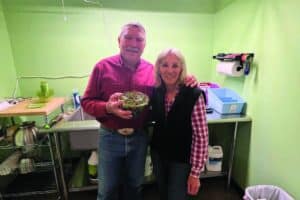Gary Barber, consultant for the El Paso County Water Authority, spoke at the Protect Our Wells November meeting and painted a bleak picture for El Paso County private well owners.”The natural water supply for the Colorado Springs area is enough to support about 100,000 people, and the water that is now imported from the western slope sustains about 400,000 people,” Barber said.Rural areas are caught in the middle of the water battle as well. Barber said growth is driving the questionable long-term viability of the rural area wells that rely on underground water.According to the 2000 census, there are 4.3 million people in Colorado. “The Colorado Water Conservation Board projected 7 million residents by 2030, and that doesn’t even count recent growth at Ft. Carson,” Barber said. “Half our population growth comes from births and increased longevity. The other half comes from people moving here. The Fountain area alone is projected to grow from 20,000 to 80,000 residents. El Paso County currently has a gap of 8,000-acre feet (of water).”An October report from the Colorado state engineer’s office shows that the Upper Black Squirrel alluvial aquifer provides water to over 8,500 households in Black Forest, Falcon, Peyton and Ellicott. That aquifer also is being mined by large commercial and agricultural wells, causing water levels to drop. Some private well owners have had to drill deeper or drill new wells, Barber said.As one solution, the Colorado Springs Utilities has proposed the Southern Delivery System, which will bring water north from the Arkansas River near Pueblo to the Jimmy Camp Reservoir.However, the SDS doesn’t help private well owners on the eastern plains. “It is possible, but not probable, that a pipeline could be run from Jimmy Camp Reservoir through the Black Forest, and up to the Monument area,” Barber said. But he added that it’s more likely a mill levy would be imposed to raise funds for recharging the aquifers. “Right now, we don’t know where we would get the water for a recharge project. Politically, it’s hard to get the western slope to agree to give us more water,” he said.Agricultural areas along the Arkansas River might be a more likely source. “The agricultural economy in the Arkansas Basin is dying,” Barber said. “The cantaloupes at the grocery store come from Mexico now, not southern Colorado. One hundred fifty years of irrigating land in the Arkansas Basin has led to salinity problems. Or, if they keep farming, we might be able to get water from them when they let their fields go fallow.”Political will to solve Colorado’s water problem has been lacking, he said. The El Paso County Water Authority consists of local water districts, but does not include Colorado Springs Utilities, he said. “You have to realize that the water authority is basically a coffee club,” Barber added.In 2005, Gov. Owens signed House Bill 1177, which created nine water-related roundtables throughout the state. Members of the roundtables include representatives of local water districts and local governments; 54 members sit on the El Paso County roundtable. Each roundtable sends two members to a statewide committee. Barber said the theory for creating a statewide committee is that “by getting to know each other’s issues and concerns a consensus will be reached at a grass-roots level.”Barber said he advocates storing more water. “We can convert mined out gravel pits to water storage. Just put in a slurry wall to prevent leakage,” he said. “We can store water in the ground. The coarser the soil, the greater its storage capacity. That’s what Tucson does with the water we send down there … they bank it. We could even build a desalinization plant for California in exchange for reducing their water allocation from the Colorado River.””We have to look at every bit of recharge, including treated waste water, that we can get,” said Kathy Hare, president of the Upper Black Squirrel Creek Groundwater Management District Board. “When we recharge, we protect the Denver Basin. I know the thought of using treated waste water sounds horrible, but the technology is available, and we need to save every drop we can.”Barber said the good news is that the Dawson aquifer – the water source for most private wells in the Falcon, Black Forest, Peyton and Calhan areas – may recharge naturally, beyond what they had previously estimated. “But it doesn’t recharge fast enough to keep up with usage,” he said.Barber said most people don’t understand water issues because of the science involved. Which often creates panic for small towns that think they’ll be pumped dry by the big cities.Joking, he said, “You have to remember that power and money move water uphill.”






